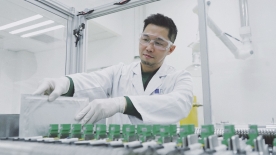- Offers safety, performance and simplification for excellent all-climate serviceability
- Promises broad applicability across industries to accelerate electrification
SHANGHAI – A game-changing high-power bipolar solid-state battery technology developed by the GM China Science Lab in Shanghai has received the 2022 R&D 100 Award.
Often referred to as “The Oscars of Innovation,” the global honor is presented annually by R&D World magazine to recognize 100 of the most influential products, technologies and materials for their technological significance. It has long been a benchmark of excellence for the science and technology sectors.
“The development of the high-power bipolar solid-state battery is the result of GM’s intrapreneurship culture, open innovation spirit and outstanding talent,” said Julian Blissett, GM executive vice president and president of GM China. “The continual incubation of groundbreaking innovations is allowing us to shape future mobility and driving us faster toward GM’s goal of carbon neutrality by 2040 and vision of zero crashes, zero emissions and zero congestion.”
The highly manufacturable battery technology offers excellent thermal stability and abuse tolerance, compared with conventional liquid electrolyte. Its unique bipolar stacking and proprietary interfacial ionic booster greatly enhance its all-climate serviceability and give it a simplified configuration, leading to a 30% higher volumetric cell-to-pack ratio and 19% pack cost reduction over conventional Li-ion batteries.
“Electrification is crucial for global carbon neutrality,” said Dr. Helen Liu, manager of the Battery Lab Group at the GM China Science Lab. “With higher performance and lower costs, our highly safe battery innovation offers huge potential applications for promoting electrification inside and outside the automotive industry.”
With proven cold power robustness and excellent all-climate performance, the high-power bipolar solid-state battery promises broad applicability for energy storage devices for low-voltage systems. It can be applied to 12V start/stop, 48V mild hybrid and battery-assisted systems, creating greater commercial synergy with Li-ion batteries for pure electric vehicles. The invention will support GM’s Ultium platform, furthering the company’s EV momentum. It also offers the potential to empower other industries, such as locomotives, wind power generation and mobile medical equipment, to help them accelerate their transition to an all-electric future.
The incubator of this groundbreaking technology, GM China’s Battery Lab is the first facility of its kind operated in China by a foreign automaker. It has established a full-fledged capability in advanced battery materials, cell design and manufacturing since it was founded a decade ago, having a game-changing effect on low-voltage and hybrid electric vehicle systems, as well as non-automotive applications requiring high-power response. Researchers are now working on next-generation high-energy battery solutions that are more affordable, ranging from conventional high-power batteries to visionary solid-state batteries.
The high-power bipolar solid-state battery is the third R&D 100 Award-winning technology developed by the GM China Science Lab, which was founded in 2009. The direct remote laser welding process and system innovation and the capacitor-assisted battery (CAB) received the honors in 2016 and 2019 respectively. The CAB has already been licensed to several global battery manufacturers for mass production.
General Motors (NYSE:GM) is driving the future of transportation, leveraging advanced technology to build safer, smarter, and lower emission cars, trucks, and SUVs. GM’s Buick, Cadillac, Chevrolet, GMC, Baojun and Wuling brands offer a broad portfolio of innovative gasoline-powered vehicles and the industry’s widest range of EVs, as we move to an all-electric future. Learn more at GM.com.
